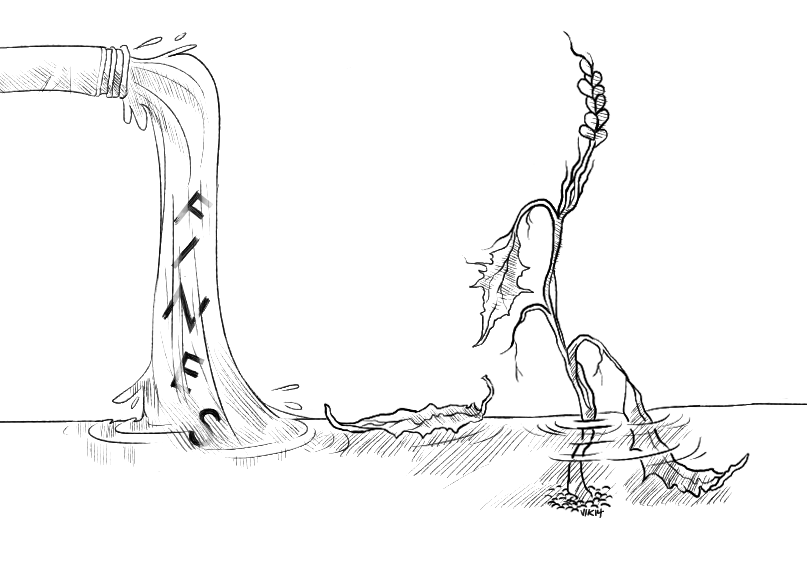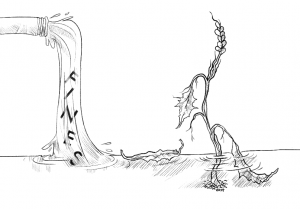“State of Emergency” should inspire more urgency
With the surplus of news segments, radio advertisements, and flashing reminders on the side of the freeway, everyone in California knows that the state is in the midst of a drought. Even with this knowledge, many Californians are blatantly ignoring the severity of the situation and continuing in their daily water habits without adjusting to the reality of the drought.
California residents are seasoned veterans of droughts, and have become nearly immune to the flurry of reminders to save water. However, this drought is the most severe drought on record in the state’s history. It is serious enough that in January, Governor Jerry Brown officially declared the drought a State of Emergency, and set a goal for the state to cut water usage by 20 percent.
While setting the record for the most severe drought on record, it seems as if California might also set the record for the most lackluster response to an emergency situation in recent history.
The drought simply doesn’t feel like an emergency. Residents are hardly in a state of panic; water habits largely remain unchanged, and many residents are just now starting to cut back on water usage.
An outsider observing water habits in California would never guess that the state currently only has enough water in storage to last 12 to 18 months. The lush lawns, green golf courses, and constantly clean cars certainly don’t point to the issue. For the most part, the “State of Emergency” is yet to make a palpable difference in the state’s water habits.
Some people argue that it’s pointless for residents to cut back on their daily water use because residential water usage is so small in comparison to commercial and agricultural water usage. This argument would be valid if residential water usage was completely insignificant compared to commercial use, but in reality, this is not the case.
Although residential usage makes up just approximately 14 percent of California’s total water use, that’s substantial enough for individual water conservation to make a difference, if enough individuals conserve. Individual conservation is particularly imperative in Los Angeles, where annual residential water sales surpasses annual commercial water sales by 73 billion gallons.
Governor Jerry Brown’s call for a 20 percent reduction in water use wasn’t meant just for commercial users, nor was it directed only at residential users. Corporations and individual residents alike should take the 20% reduction goal as motivation to be more responsible about water use.
Water conservation begins at the individual level, especially since residential water use offers myriad opportunities for conservation. Voluntary conservation methods range from simply taking shorter showers to completely new landscaping.
Unfortunately, Californians historically haven’t been eager about voluntary conservation. If residents were more proactive about conserving water prior to the drought, there would currently be more water in storage.
This is exactly why government officials needed to step in. On July 15th, officials approved an emergency state rule that allows authorities to fine residents caught wasting water up to five hundred dollars.
Finable practices include excessive runoff from outdoor sprinklers, hosing off driveways, and decorative fountains that don’t reuse water.
These measures will hopefully at the very least force residents to start taking the drought seriously, and instill a sense of urgency. Obviously, not everyone who wastes water will be fined, so the new litigation probably won’t scare everyone into conserving water.
These fines basically function as a public service announcement. Their mere existence proves the seriousness of the drought, and hopefully this will motivate residents to make smarter water choices. Commercial sites can conserve water through the same practices as residents, only on a larger scale. For example, farmers and residents alike can abstain from growing non-native, water-guzzling plants. Even at the commercial level, water conservation depends on individual initiative. Farms, businesses, and factories are all led by individuals, and once these individuals make water conservation a habit at home, they could bring these concepts with them to their workplace.
Once again, solving California’s water shortage ultimately comes down to individual conservation efforts. It’s simple: all California residents use California’s water, so everyone is responsible for saving it.
Besides Jerry Brown’s 20 percent reduction goal, here’s another goal for California residents: make the drought conservation efforts a daily habit. Instead of returning to old wasteful habits once the dry season ends, Californians should consistently strive to conserve water. Proactive prevention eliminates the need for future emergency control.


